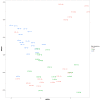Temperature Driven Changes in Benthic Bacterial Diversity Influences Biogeochemical Cycling in Coastal Sediments
- PMID: 30190707
- PMCID: PMC6115492
- DOI: 10.3389/fmicb.2018.01730
Temperature Driven Changes in Benthic Bacterial Diversity Influences Biogeochemical Cycling in Coastal Sediments
Abstract
Marine sediments are important sites for global biogeochemical cycling, mediated by macrofauna and microalgae. However, it is the microorganisms that drive these key processes. There is strong evidence that coastal benthic habitats will be affected by changing environmental variables (rising temperature, elevated CO2), and research has generally focused on the impact on macrofaunal biodiversity and ecosystem services. Despite their importance, there is less understanding of how microbial community assemblages will respond to environmental changes. In this study, a manipulative mesocosm experiment was employed, using next-generation sequencing to assess changes in microbial communities under future environmental change scenarios. Illumina sequencing generated over 11 million 16S rRNA gene sequences (using a primer set biased toward bacteria) and revealed Bacteroidetes and Proteobacteria dominated the total bacterial community of sediment samples. In this study, the sequencing coverage and depth revealed clear changes in species abundance within some phyla. Bacterial community composition was correlated with simulated environmental conditions, and species level community composition was significantly influenced by the mean temperature of the environmental regime (p = 0.002), but not by variation in CO2 or diurnal temperature variation. Species level changes with increasing mean temperature corresponded with changes in NH4 concentration, suggesting there is no functional redundancy in microbial communities for nitrogen cycling. Marine coastal biogeochemical cycling under future environmental conditions is likely to be driven by changes in nutrient availability as a direct result of microbial activity.
Keywords: benthic biogeochemistry; benthic microbial ecology; biogeochemical cycles; environmental change; marine sediments; microbial communities.
Figures






References
-
- Alsterberg C., Hulth S., Sundbäck K. (2011). Response of a shallow-water sediment system to warming. Limnol. Oceanogr. 56, 2147–2160. 10.4319/lo.2011.56.6.2147 - DOI
-
- Beaumont N. J., Austen M. C., Atkins J. P., Burdon D., Degraer S., Dentinho T. P., et al. (2007). Identification, definition and quantification of goods and services provided by marine biodiversity: implications for the ecosystem approach. Mar. Pollut. Bull. 54, 253–265. 10.1016/j.marpolbul.2006.12.003 - DOI - PubMed
LinkOut - more resources
Full Text Sources
Other Literature Sources

